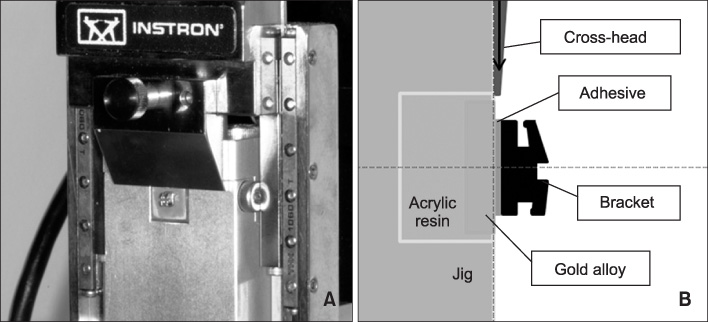Korean J Orthod.
2009 Oct;39(5):320-329.
Effect of metal primer and thermocycling on shear bonding strength between the orthodontic bracket and gold alloy
- Affiliations
-
- 1Graduate Student, Department of Orthodontics, College of Dentistry, Yonsei University, Korea.
- 2Assistant Professor, Department of Orthodontics, College of Dentistry, Yonsei University, Korea.
- 3Professor, Department of Orthodontics, College of Dentistry, Oral Science Research Institute, The Institute of Cranio-facial Deformity, Yonsei University, Korea. hwang@yuhs.ac
Abstract
OBJECTIVE
The aim of this study was to evaluate the effect of metal primers and thermocycling on shear bond strength between the orthodontic bracket and gold alloy.
METHODS
For this study, 80 specimens made of dental gold alloy were divided into 8 groups based on the combination of metal primers (none, Alloy primer, Metaltite, V-primer) and thermocycling (with and without thermocycling). Shear bond strength testing was performed with a universal testing machine. Bond failure sites were classified by a modified ARI (Adhesive Remnant Index) score.
RESULTS
All metal primer treated groups showed a significantly higher shear bond strength than the only sandblasting treated group without thermocycling (p<0.05). There were no significant differences on shear bond strength in the groups with thermocycling (p>0.05). Bond failure sites of the metal primer treated group without thermocycling occurred at gold alloy/adhesive interface, whereas there were no differences on bonding failure sites in the groups with thermocycling.
CONCLUSIONS
These findings suggest that using metal primer on gold alloy enhances the initial bracket bond strength. But, this effect was not shown with thermocycling.
Keyword
MeSH Terms
Figure
Reference
-
1. Yu HS, Ryu YK, Lee JY. A study on the distributions and trends in malocclusion patients from Department of Orthodontics, College of Dentistry, Yonsei University. Korean J Orthod. 1999. 29:267–276.2. Buonocore MG. A simple method of increasing the adhesion of acrylic filling materials to enamel surfaces. J Dent Res. 1955. 34:849–853.
Article3. Newman GV. Epoxy adhesives for orthodontic attachments: progress report. Am J Orthod. 1965. 51:901–912.
Article4. Keim RG, Gottlieb EL, Nelson AH, Vogels DS 3rd. 2002 JCO study of orthodontic diagnosis and treatment procedures. Part 1. Results and trends. J Clin Orthod. 2002. 36:553–568.5. Boyd RL, Baumrind S. Periodontal considerations in the use of bonds or bands on molars in adolescents and adults. Angle Orthod. 1992. 62:117–126.6. Proffit WR, Fields HW, Sarver DM. Contemporary orthodontics. 2007. 4th ed. St. Louis: Mosby Elsevier;658–659.7. Wood DP, Jordan RE, Way DC, Galil KA. Bonding to porcelain and gold. Am J Orthod. 1986. 89:194–205.
Article8. Andreasen GF, Stieg MA. Bonding and debonding brackets to porcelain and gold. Am J Orthod Dentofacial Orthop. 1988. 93:341–345.
Article9. Büyükyilmaz T, Zachrisson YO, Zachrisson BU. Improving orthodontic bonding to gold alloy. Am J Orthod Dentofacial Orthop. 1995. 108:510–518.
Article10. Graber TM, Vanarsdall RL, Vig KWL. Orthodontics: current principles and techniques. 2005. 4th ed. St. Louis: Elsevier Mosby;596–602.11. Gale MS, Darvell BW. Thermal cycling procedures for laboratory testing of dental restorations. J Dent. 1999. 27:89–99.
Article12. Bishara SE, Ajlouni R, Laffoon JF. Effect of thermocycling on the shear bond strength of a cyanoacrylate orthodontic adhesive. Am J Orthod Dentofacial Orthop. 2003. 123:21–24.
Article13. Artun J, Bergland S. Clinical trials with crystal growth conditioning as an alternative to acid-etch enamel pretreatment. Am J Orthod. 1984. 85:333–340.
Article14. Zachrisson BU. Orthodontic bonding to artificial tooth surfaces: clinical versus laboratory findings. Am J Orthod Dentofacial Orthop. 2000. 117:592–594.
Article15. Kojima K, Kadoma Y, Imai Y. Adhesion to precious metals utilizing triazine dithione derivative monomer. J Jpn Dent Mater. 1987. 6:702–707.16. Suzuki M, Fujishima A, Miyazaki T, Hisamitsu H, Kojima K, Kadoma Y. A study on the adsorption structure of an adhesive monomer for precious metals by surface-enhanced Raman scattering spectroscopy. Biomaterials. 1999. 20:839–845.
Article17. Ryou DB, Kwon TY, Kwon YH, Kim KH. An effect priming gold alloy on bonding to orthodontic bracket. J Korean Res Soc Dent Mater. 2003. 30:347–356.18. Yanagida H, Matsumura H, Atsuta M. Bonding of prosthetic composite material to Ti-6Al-7Nb alloy with eight metal conditioners and a surface modification technique. Am J Dent. 2001. 14:291–294.19. Tanaka T, Fujiyama E, Shimizu H, Takaki A, Atsuta M. Surface treatment of nonprecious alloys for adhesion-fixed partial dentures. J Prosthet Dent. 1986. 55:456–462.
Article20. Sparrius O, Grossman ES. Marginal leakage of composite resin restorations in combination with dentinal and enamel bonding agents. J Prosthet Dent. 1989. 61:678–684.
Article21. Kang SW, Son WS, Park SB, Kim SS. Effect of thermocycling on shear bond strength and mode of failure of ceramic orthodontic brackets bonded to different porcelain restorations. Korean J Orthod. 2009. 39:225–233.
Article22. Atsuta M, Matsumura H, Tanaka T. Bonding fixed prosthodontic composite resin and precious metal alloys with the use of a vinyl-thiol primer and an adhesive opaque resin. J Prosthet Dent. 1992. 67:296–300.
Article23. Matsumura H, Shimoe S, Nagano K, Atsuta M. Effect of noble metal conditioners on bonding between prosthetic composite material and silver-palladium-copper-gold alloy. J Prosthet Dent. 1999. 81:710–714.
Article24. Yoshida K, Atsuta M. Effect of MMA-PMMA resin polymerization initiators on the bond strengths of adhesive primers for noble metal. Dent Mater. 1999. 15:332–336.
Article25. Reynolds IR. A review of direct orthodontic bonding. Br J Orthod. 1975. 2:171–178.
Article
- Full Text Links
- Actions
-
Cited
- CITED
-
- Close
- Share
- Similar articles
-
- Shear bond strength between gold alloy and orthodontic metal bracket using light emitting diode curing light
- THE EFFECTS OF METAL SURFACE TREATMENTS ON THE BONE STRENGTH OF POLYMETHYL METHACRYLATE BONDED REMOVABLE PROSTHESE
- Effect of silica coating on bond strength between a gold alloy and metal bracket bonded with chemically cured resin
- A comparative study on bond strength and adhesive failure pattern in bracket bonding with self-etching primer
- Shear bond strength of heat-cured denture base resin to surface treated Co-Cr alloy with different methods


